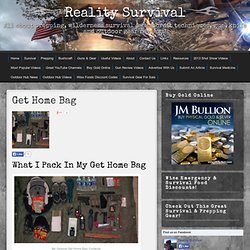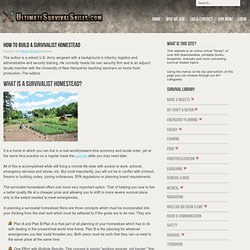

Get Home Bag Contents. My Original Get Home Bag Contents A Get Home Bag is essentially the little brother to the Bug Out Bag.

The Get Home Bag is lighter and smaller and built for quick movement to assist you in one purpose, getting home! The Get Home Bag is meant to be left in your primary every day use vehicle and it just sits and waits until needed in an emergency. In July 2011, I initially wrote an article about my Vehicle Every Day Carry items and included in that list was a Get Home Bag. Here is an updated look at what I currently carry in my Get Home Bag.
All of the gear in my Get Home Bag fits nicely in a small backpack and it all weighs about 22 lbs. While most all of the items in a Get Home Bag should have multiple uses the extra cell phone battery, the cash, prepaid calling card and emergency credit card are in all likelihood the most useful in most real world emergencies (non-SHTF type scenarios). Check out this newer article with a couple of recent videos on the topic of Get Home Bags! How to Make a Bug Out Bag. Extreme Urban Gardening: Straw Bale Gardens. Here’s a very simple technique for gardening in tight spots and in places with no/terrible soil (from the arctic circle to the desert to an asphalt jungle).

It’s also a great way to garden if you have limited mobility (in a wheel chair). What is Straw Bale Gardening? You simply plant your garden in straw bales. Here’s an example of what a straw bale garden looks like (via author/expert Joel Karsten — he’s got a good book on the topic and he teaches it in seminars) As you can see, the basic technique is actually quite simple. How to grow a Straw Bale Garden There are lots of techniques on how to grow a straw bale garden. Days 1 to 3: Water the bales thoroughly and keep them damp.Days 4 to 6: Sprinkle each bale with ½ cup urea (46-0-0) and water well into bales.
Essentially, plant the seedlings like you would do in the ground. Remember, the bales (like most above ground gardening techniques) will need extra water and fertilizer during the early period. Plants Number Per Bale. 9 Steps To Starting A Survival Garden. In a time of economic uncertainty and rising food prices, it it always a good idea to have a garden to provide extra food for you and your family.

Besides providing a source of food in an emergency, a garden is also a great source of wonderful vegetables which are MUCH healthier to eat than most of the food you can get at the supermarket. So how do you begin? The following are 9 steps that you can take to get your garden started..... #1) Decide What Your Goals Are - Do you want to grow enough just to add a few vegetables to your dinner once in a while?
Do you want it to be able to provide enough food for your family if there is a major emergency? Some people who want to live "off the grid" end up building a garden large enough that it will provide almost all of the food that their family needs. . #2) Evaluate Your Land - Once you know what your goals are, you need to evaluate the land that you are currently living on. So what is the solution? Comments comments. How to Build a Survivalist Homestead - A Complete Guide.
The author is a retired U.S.

Army sergeant with a background in infantry, logistics and administrative and security training. He currently heads his own security firm and is an adjunct faculty member with the University of New Hampshire teaching seminars on home food production. -The editors. It is a home in which you can live in a real-world/present-time economy and social order, yet at the same time practice on a regular basis the survival skills you may need later.
All of this is accomplished while still living a normal life-style with access to work, schools, emergency services and stores, etc. The survivalist homestead offers one more very important option. In planning a survivalist homestead there are three concepts which must be incorporated into your thinking from the start and which must be adhered to if the goals are to be met. Plan A and Plan B-Plan A is that part of all planning of your homestead which has to do with dealing in the present/real world time frame. 1. 2. 3. 4.